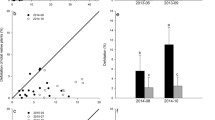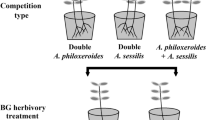Abstract
Plants in nature are often attacked by multiple enemies whose effect on the plant cannot always be predicted based on the outcome of individual attacks. We investigated how two invasive herbivores, the hemlock woolly adelgid (Adelges tsugae) (HWA) and the elongate hemlock scale (Fiorinia externa) (EHS), alter host plant quality (measured as amino acid concentration and composition) when feeding individually or jointly on eastern hemlock (Tsuga canadensis), an important long-lived forest tree that is in severe decline. The joint herbivore treatments included both simultaneous and sequential infestations by the two herbivores. We expected resource depletion over time, particularly in response to feeding by HWA. In contrast, HWA dramatically increased the concentration and altered the composition of individual free amino acids. Compared to control trees, HWA increased total amino acid concentration by 330% after 1 year of infestation. Conversely, EHS had a negligible effect when feeding individually. Interestingly, there was a marginally significant HWA × EHS interaction that suggests the potential for EHS presence to reduce the impact of HWA on foliage quality when the two species co-occur. We suggest indirect effects of water stress as a possible physiological mechanism for our results. Understanding how species interactions change the physiology of a shared host is crucial to making more accurate predictions about host mortality and subsequent changes in affected communities and ecosystems, and to help design appropriate management plans.


Similar content being viewed by others
References
Bacheller JD, Romeo JT (1992) Biotic and abiotic stress effects on nitrogen chemistry in the salt marsh cordgrass Spartina alterniflora (poaceae). Chemoecology 3:74–80
Behmer ST, Joern A (1994) The influence of proline on diet selection—sex-specific feeding preferences by the grasshoppers Ageneotettix deorum and Phoetaliotes nebrascensis (orthoptera, acrididae). Oecologia 98:76–82
Branson DH (2010) Density-dependent effects of an early season insect herbivore on a later developing insect herbivore. Environ Entomol 39:346–350
Butin E, Preisser EL, Elkinton J (2007) Factors affecting settlement rate of the hemlock woolly adelgid, Adelges tsugae, on eastern hemlock, Tsuga canadensis. Agric For Entomol 9:215–219
Chen JQ, Rahbe Y, Delobel B, Sauvion N, Guillaud J, Febvay G (1997) Melon resistance to the aphid Aphis gossypii: behavioural analysis and chemical correlations with nitrogenous compounds. Entomol Exp Appl 85:33–44
Cobb RC (2010) Species shift drives decomposition rates following invasion by hemlock woolly adelgid. Oikos 119:1291–1298
Cockfield SD (1988) Relative availability of nitrogen in host plants of invertebrate herbivores—3 possible nutritional and physiological definitions. Oecologia 77:91–94
Danoff-Burg J, Bird S (2002) Hemlock woolly adelgid and elongate hemlock scale: partners in crime? In: Onken B, Reardon R, Lashomb J (eds) Symposium on the hemlock woolly adelgid in Eastern North America. US Forest Service, New Brunswick, pp 254–268
de Boer JG, Hordijk CA, Posthumus MA, Dicke M (2008) Prey and non-prey arthropods sharing a host plant: effects on induced volatile emission and predator attraction. J Chem Ecol 34:281–290
Delauney AJ, Verma DPS (1993) Proline biosynthesis and osmoregulation in plants. Plant J 4:215–223
Denno RF, McClure MS, Ott JR (1995) Interspecific interactions in phytophagous insects—competition reexamined and resurrected. Annu Rev Entomol 40:297–331
Eleftherianos I, Vamvatsikos P, Ward D, Gravanis F (2006) Changes in the levels of plant total phenols and free amino acids induced by two cereal aphids and effects on aphid fecundity. J Appl Entomol 130:15–19
Erb M, Robert CAM, Hibbard BE, Turlings TCJ (2011) Sequence of arrival determines plant-mediated interactions between herbivores. J Ecol 99:7–15
Febvay G, Bonnin J, Rahbe Y, Bournoville R, Delrot S, Bonnemain JL (1988) Resistance of different lucerne cultivars to the pea aphid Acyrthosiphon pisum—influence of phloem composition on aphid fecundity. Entomol Exp Appl 48:127–134
Gade G, Auerswald L (2002) Beetles’ choice—proline for energy output: control by AKHs. Comp Biochem Physiol B-Biochem Mol Biol 132:117–129
Giordanengo P, Brunissen L, Rusterucci C, Vincent C, van Bel A, Dinant S, Girousse C, Faucher M, Bonnemain J (2010) Compatible plant-aphid interactions: how aphids manipulate plant responses. C R Biol 333:516–523
Gómez S, Ferrieri RA, Schueller M, Orians CM (2010a) Methyl jasmonate elicits rapid changes in carbon and nitrogen dynamics in tomato. New Phytol 188:835–844
Gómez S, van Dijk W, Stuefer JF (2010b) Timing of induced resistance in a clonal plant network. Plant Biol 12:512–517
Hare PD, Cress WA (1997) Metabolic implications of stress-induced proline accumulation in plants. Plant Growth Regul 21:79–102
Havill NP, Foottit RG (2007) Biology and evolution of adelgidae. Annu Rev Entomol 52:325–349
Huberty AF, Denno RF (2004) Plant water stress and its consequences for herbivorous insects: a new synthesis. Ecology 85:1383–1398
Inbar M, Doostdar H, Leibee GL, Mayer RT (1999) The role of plant rapidly induced responses in asymmetric interspecific interactions among insect herbivores. J Chem Ecol 25:1961–1979
Jenkins JC, Aber JD, Canham CD (1999) Hemlock woolly adelgid impacts on community structure and N cycling rates in eastern hemlock forests. Can J For Res 29:630–645
Kaplan I, Denno RF (2007) Interspecific interactions in phytophagous insects revisited: a quantitative assessment of competition theory. Ecol Lett 10:977–994
Karban R, Baldwin IT (1997) Induced responses to herbivory. University of Chicago Press, Chicago
Karley AJ, Douglas AE, Parker WE (2002) Amino acid composition and nutritional quality of potato leaf phloem sap for aphids. J Exp Bot 205:3009–3018
Knochel DG, Monson ND, Seastedt TR (2010) Additive effects of aboveground and belowground herbivores on the dominance of spotted knapweed (Centaurea stoebe). Oecologia 164:701–712
Liebhold AM, Macdonald WL, Bergdahl D, Maestro VC (1995) Invasion by exotic forest pests—a threat to forest ecosystems. For Sci 41:1–49
Marquis RJ (1990) Genotypic variation in leaf damage in Piper arieianum (Piperaceae) by a multispecies assemblage of herbivores. Evolution 44:104–120
Mattson WJ (1980) Herbivory in relation to plant nitrogen-content. Annu Rev Ecol Syst 11:119–161
McClure MS (1980a) Foliar nitrogen—a basis for host suitability for elongate hemlock scale, Fiorinia externa (Homoptera: Diaspididae). Ecology 61:72–79
McClure MS (1980b) Competition between exotic species—scale insects on hemlock. Ecology 61:1391–1401
McClure MS (1991) Density-dependent feedback and population-cycles in Adelges tsugae (Homoptera: Adelgidae) on Tsuga canadensis. Environ Entomol 20:258–264
McClure MS (2002) The elongate hemlock scale, Fiorinia externa Ferris (Homoptera: Diaspididae): a new look at an old nemesis. In: Onken B, Reardon R, Lashomb J (eds) Symposium on the hemlock woolly adelgid in Eastern North America. US Forest Service, New Brunswick, pp 248–253
Meyer ST, Roces F, Wirth R (2006) Selecting the drought stressed: effects of plant stress on intraspecific and within-plant herbivory patterns of the leaf-cutting ant Atta colombica. Funct Ecol 20:973–981
Miller-Pierce MR, Orwig DA, Preisser EL (2010) Effects of hemlock woolly adelgid and elongate hemlock scale on eastern hemlock growth and foliar chemistry. Environ Entomol 39:513–519
Orwig DA, Foster DR (1998) Forest response to the introduced hemlock woolly adelgid in southern New England, USA. J Torrey Bot Soc 125:60–73
Poelman EH, Broekgaarden C, Van Loon JJA, Dicke M (2008) Early season herbivore differentially affects plant defence responses to subsequently colonizing herbivores and their abundance in the field. Mol Ecol 17:3352–3365
Pontius JA, Hallett RA, Jenkins JC (2006) Foliar chemistry linked to infestation and susceptibility to hemlock woolly adelgid (Homoptera: Adelgidae). Environ Entomol 35:112–120
Preisser EL, Elkinton JS (2008) Exploitative competition between invasive herbivores benefits a native host plant. Ecology 89:2671–2677
Preisser EL, Lodge AG, Orwig DA, Elkinton JS (2008) Range expansion and population dynamics of co-occurring invasive herbivores. Biol Invasions 10:201–213
Radville L, Chaves A, Preisser EL (2011) Variation in plant defense against invasive herbivores: evidence for a hypersensitive response in eastern hemlocks (Tsuga canadensis). J Chem Ecol 37:592–597
Rodriguez-Saona CR, Musser RO, Vogel H, Hum-Musser SM, Thaler JS (2010) Molecular, biochemical, and organismal analyses of tomato plants simultaneously attacked by herbivores from two feeding guilds. J Chem Ecol 36:1043–1057
Sandstrom J, Telang A, Moran NA (2000) Nutritional enhancement of host plants by aphids—a comparison of three aphid species on grasses. J Insect Physiol 46:33–40
Soler R, Bezemer TM, Cortesero AM, Van der Putten WH, Vet LEM, Harvey JA (2007) Impact of foliar herbivory on the development of a root-feeding insect and its parasitoid. Oecologia 152:257–264
Stadler B, Muller T, Orwig DA, Cobb R (2005) Hemlock woolly adelgid in New England forests: canopy impacts transforming ecosystem processes and landscapes. Ecosystems 8:233–247
Terce-Laforgue T, Mack G, Hirel B (2004) New insights towards the function of glutamate dehydrogenase revealed during source-sink transition of tobacco (Nicotiana tabacum) plants grown under different nitrogen regimes. Physiol Plant 120:220–228
Thaler JS, Fidantsef AL, Bostock RM (2002) Antagonism between jasmonate- and salicylate-mediated induced plant resistance: effects of concentration and timing of elicitation on defense-related proteins, herbivore, and pathogen performance in tomato. J Chem Ecol 28:1131–1159
Underwood NC (1998) The timing of induced resistance and induced susceptibility in the soybean Mexican bean beetle system. Oecologia 114:376–381
Vos M, Berrocal SM, Karamaouna F, Hemerik L, Vet LEM (2001) Plant-mediated indirect effects and the persistence of parasitoid-herbivore communities. Ecol Lett 4:38–45
Walker-Lane LN (2009) The effect of hemlock woolly adelgid infestation on water relations of Carolina and eastern hemlock. Master thesis, Department of Forestry and Environmental Resources, North Carolina State University, Raleigh
White TCR (1984) The abundance of invertebrate herbivores in relation to the availability of nitrogen in stressed food plants. Oecologia 63:90–105
Yamada M, Morishita H, Urano K, Shiozaki N, Yamaguchi-Shinozaki K, Shinozaki K, Yoshiba Y (2005) Effects of free proline accumulation in petunias under drought stress. J Exp Bot 56:1975–1981
Young RF, Shields KS, Berlyn GP (1995) Hemlock woolly adelgid (Homoptera: Adelgidae)—stylet bundle insertion and feeding sites. Ann Entomol Soc Am 88:827–835
Zarate SI, Kempema LA, Walling LL (2007) Silverleaf whitefly induces salicylic acid defenses and suppresses effectual jasmonic acid defenses. Plant Physiol 143:866–875
Zvereva EL, Kozlov MV, Niemela P, Haukioja E (1997) Delayed induced resistance and increase in leaf fluctuating asymmetry as responses of Salix borealis to insect herbivory. Oecologia 109:368–373
Acknowledgments
We thank D. Cox, L. Glidden, R. Gaudio, and M. Miller-Pierce for field assistance, D. Marshall and C. Thornber for advice on statistical analyses, and N.M. Holbrook, N. Havill, J. Pezet, J. Thaler and three anonymous referees for useful comments on a previous version of the manuscript. This project was funded by the National Science Foundation, grant NSF DEB-0715504 to E. Preisser.
Author information
Authors and Affiliations
Corresponding author
Additional information
Communicated by Caroline Müller.
Electronic supplementary material
Below is the link to the electronic supplementary material.
Rights and permissions
About this article
Cite this article
Gómez, S., Orians, C.M. & Preisser, E.L. Exotic herbivores on a shared native host: tissue quality after individual, simultaneous, and sequential attack. Oecologia 169, 1015–1024 (2012). https://doi.org/10.1007/s00442-012-2267-2
Received:
Accepted:
Published:
Issue Date:
DOI: https://doi.org/10.1007/s00442-012-2267-2




